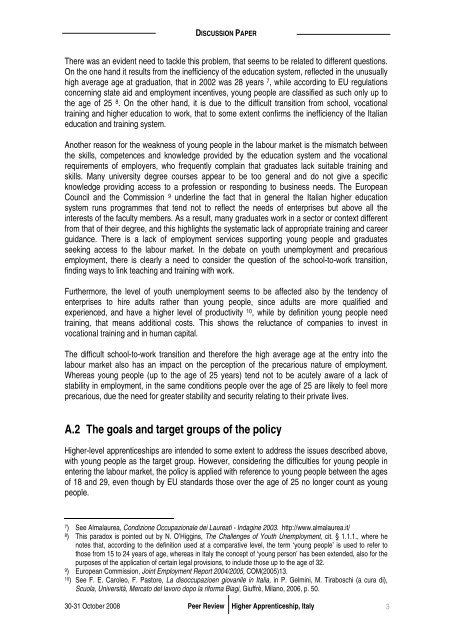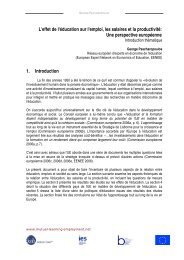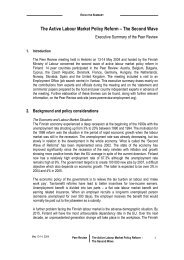Discussion Paper - Mutual Learning Programme
Discussion Paper - Mutual Learning Programme
Discussion Paper - Mutual Learning Programme
You also want an ePaper? Increase the reach of your titles
YUMPU automatically turns print PDFs into web optimized ePapers that Google loves.
DISCUSSION PAPER<br />
There was an evident need to tackle this problem, that seems to be related to different questions.<br />
On the one hand it results from the inefficiency of the education system, reflected in the unusually<br />
high average age at graduation, that in 2002 was 28 years 7 , while according to EU regulations<br />
concerning state aid and employment incentives, young people are classified as such only up to<br />
the age of 25 8 . On the other hand, it is due to the difficult transition from school, vocational<br />
training and higher education to work, that to some extent confirms the inefficiency of the Italian<br />
education and training system.<br />
Another reason for the weakness of young people in the labour market is the mismatch between<br />
the skills, competences and knowledge provided by the education system and the vocational<br />
requirements of employers, who frequently complain that graduates lack suitable training and<br />
skills. Many university degree courses appear to be too general and do not give a specific<br />
knowledge providing access to a profession or responding to business needs. The European<br />
Council and the Commission 9 underline the fact that in general the Italian higher education<br />
system runs programmes that tend not to reflect the needs of enterprises but above all the<br />
interests of the faculty members. As a result, many graduates work in a sector or context different<br />
from that of their degree, and this highlights the systematic lack of appropriate training and career<br />
guidance. There is a lack of employment services supporting young people and graduates<br />
seeking access to the labour market. In the debate on youth unemployment and precarious<br />
employment, there is clearly a need to consider the question of the school-to-work transition,<br />
finding ways to link teaching and training with work.<br />
Furthermore, the level of youth unemployment seems to be affected also by the tendency of<br />
enterprises to hire adults rather than young people, since adults are more qualified and<br />
experienced, and have a higher level of productivity 10 , while by definition young people need<br />
training, that means additional costs. This shows the reluctance of companies to invest in<br />
vocational training and in human capital.<br />
The difficult school-to-work transition and therefore the high average age at the entry into the<br />
labour market also has an impact on the perception of the precarious nature of employment.<br />
Whereas young people (up to the age of 25 years) tend not to be acutely aware of a lack of<br />
stability in employment, in the same conditions people over the age of 25 are likely to feel more<br />
precarious, due the need for greater stability and security relating to their private lives.<br />
A.2 The goals and target groups of the policy<br />
Higher-level apprenticeships are intended to some extent to address the issues described above,<br />
with young people as the target group. However, considering the difficulties for young people in<br />
entering the labour market, the policy is applied with reference to young people between the ages<br />
of 18 and 29, even though by EU standards those over the age of 25 no longer count as young<br />
people.<br />
7 ) See Almalaurea, Condizione Occupazionale dei Laureati - Indagine 2003. http://www.almalaurea.it/<br />
8 ) This paradox is pointed out by N. O’Higgins, The Challenges of Youth Unemployment, cit. § 1.1.1., where he<br />
notes that, according to the definition used at a comparative level, the term ‘young people’ is used to refer to<br />
those from 15 to 24 years of age, whereas in Italy the concept of ‘young person’ has been extended, also for the<br />
purposes of the application of certain legal provisions, to include those up to the age of 32.<br />
9 ) European Commission, Joint Employment Report 2004/2005, COM(2005)13.<br />
10 ) See F. E. Caroleo, F. Pastore, La disoccupazioen giovanile in Italia, in P. Gelmini, M. Tiraboschi (a cura di),<br />
Scuola, Università, Mercato del lavoro dopo la riforma Biagi, Giuffrè, Milano, 2006, p. 50.<br />
30-31 October 2008 Peer Review Higher Apprenticeship, Italy<br />
3





